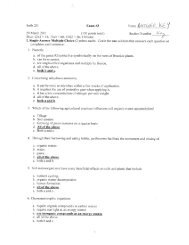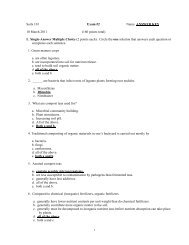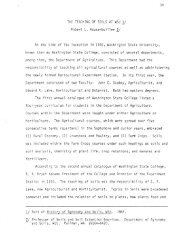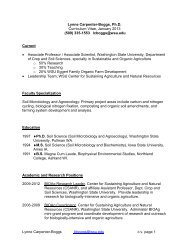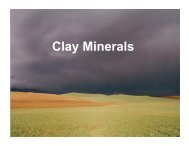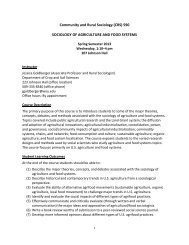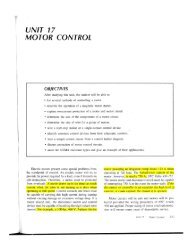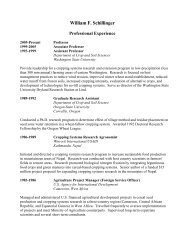2012 Dryland Field Day Abstracts - Dept. of Crop and Soil Sciences ...
2012 Dryland Field Day Abstracts - Dept. of Crop and Soil Sciences ...
2012 Dryland Field Day Abstracts - Dept. of Crop and Soil Sciences ...
Create successful ePaper yourself
Turn your PDF publications into a flip-book with our unique Google optimized e-Paper software.
Part 3. Agronomy, Economics, <strong>and</strong> Sustainability Page 41<br />
Changes in Use <strong>of</strong> Conservation Practices in Whitman <strong>and</strong> Latah Counties, 1980-2010<br />
Doug Young, School <strong>of</strong> Economic <strong>Sciences</strong>, WSU <strong>and</strong> Stephanie Kane, Social Science Research Unit, U <strong>of</strong> I<br />
STEEP researchers surveyed 306 r<strong>and</strong>omly selected farmers in 1980, <strong>and</strong> 279 in 2010, in Latah, ID <strong>and</strong> Whitman, WA counties. The<br />
results in Table 1 show great growth in direct seeding in these eastern Palouse counties over three decades. Most other<br />
conservation practices have also enjoyed greater use recently. The results are not acreage-weighted, but show some degree <strong>of</strong> use<br />
or awareness by responding farmers. In part, this progress might be attributed to conservation research <strong>and</strong> extension by STEEP<br />
<strong>and</strong> other groups over the past from 1974 to the present. Increased stewardship values over time do not appear to underlie the<br />
results because in 2010 65% <strong>of</strong> respondents would forego income/acre ranging from $3-$20 to reduce erosion compared to only<br />
48% in 2010. Lower fractions were also concerned by <strong>of</strong>f-site erosion damage in 2010.<br />
Table 1. Percentage <strong>of</strong> farmers in Latah <strong>and</strong> Whitman counties reporting use or awareness <strong>of</strong><br />
conservation practices in 1980 (italicized, first row) <strong>and</strong> 2010 (second row)<br />
Practice<br />
a. Minimum<br />
tillage *<br />
b. Direct<br />
seeding or notill<br />
****<br />
c. Divided<br />
slope<br />
farming/Strip<br />
cropping, ns<br />
d. Seeding<br />
critical areas<br />
to grass, L<br />
e. Leave<br />
stubble st<strong>and</strong><br />
during<br />
winter, **<br />
f. Sediment<br />
basins or gully<br />
plugs, ***<br />
g. Terraces, ***<br />
now<br />
using<br />
56<br />
64<br />
5<br />
37<br />
37<br />
38<br />
61<br />
57<br />
27<br />
43<br />
14<br />
30<br />
3<br />
10<br />
used in<br />
the<br />
past<br />
7<br />
13<br />
2<br />
17<br />
8<br />
19<br />
11<br />
8<br />
28<br />
16<br />
3<br />
8<br />
1<br />
3<br />
plan on<br />
using in<br />
the<br />
future<br />
2<br />
5<br />
4<br />
8<br />
2<br />
1<br />
5<br />
5<br />
1<br />
4<br />
3<br />
5<br />
2<br />
1<br />
interested<br />
in, but not<br />
sure<br />
do not<br />
plan to<br />
use<br />
not<br />
aware<br />
<strong>of</strong> it<br />
not<br />
applicable<br />
Notes: Row percentages may not sum to 100 due to rounding.<br />
The one-tailed Jonckheere-Terpstra test is used throughout. NA responses are excluded in the statistical<br />
tests. **** implies change at .0001 signif. level, *** at .001 level, ** at .01 level. * at .05 level. ns = not<br />
significant. “L“ denotes less adoption in 2010 vs 1980.<br />
Why Did Eastern Washington Wheat Growers Reject the 2011 BCAP Camelina Incentive Program?<br />
Doug Young, School <strong>of</strong> Economic <strong>Sciences</strong>, SES; Suzette Galinato <strong>and</strong> Tom Marsh, SES <strong>and</strong> IMPACT Center, WSU<br />
Wheat growers must have sharp pencils when evaluating shifting markets, evolving government commodity programs, new<br />
regulations, investment opportunities from business firms, new technologies <strong>of</strong>fered by researchers, new products from<br />
agribusinesses, <strong>and</strong> incentive programs to solve national problems. The recent Biomass <strong>Crop</strong> Assistance Program (BCAP) is an<br />
example <strong>of</strong> an incentive program to reduce U.S. dependence on fossil fuels. The BCAP, with signups in summer 2011, <strong>of</strong>fered<br />
annual payments, subject to deductions, as incentives to eligible operators to produce camelina oilseed for bio-based products <strong>and</strong><br />
18<br />
3<br />
27<br />
13<br />
15<br />
3<br />
4<br />
7<br />
3<br />
5<br />
16<br />
6<br />
10<br />
5<br />
13<br />
3<br />
14<br />
14<br />
17<br />
20<br />
11<br />
14<br />
22<br />
19<br />
30<br />
27<br />
35<br />
52<br />
0<br />
0<br />
0<br />
0<br />
1<br />
0<br />
0<br />
1<br />
0<br />
0<br />
5<br />
5<br />
1<br />
1<br />
3<br />
10<br />
4<br />
11<br />
20<br />
19<br />
8<br />
7<br />
1<br />
12<br />
31<br />
18<br />
48<br />
28




